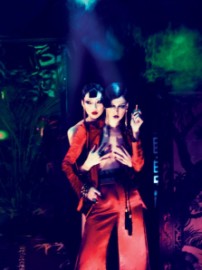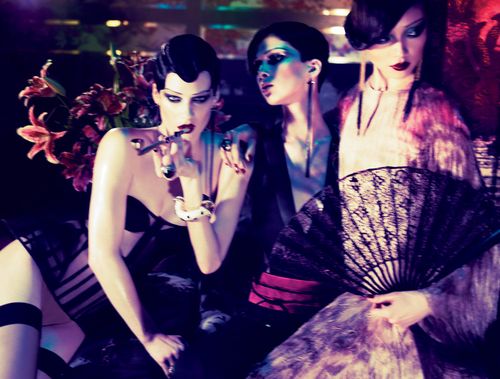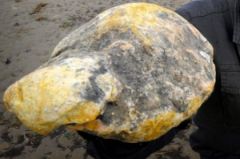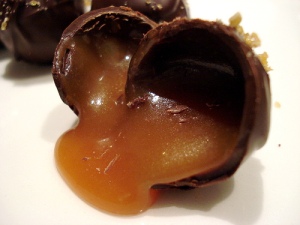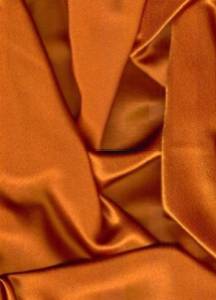The room was a glowing box of silk and soft woods, decorated in shades of gold, bronze, umber, red and brown. The one touch of colour came from the crimson lacquered boxes emitting smoke. It was an opium palace, an amber palace, a place of soft luxury. As the woman stood at the threshold, she took one long, red-taloned finger and ran it down the column of her neck. She could feel the smoke, spices and vanillic powder coating her bare skin, cloaking her in its soft, sheer, silken caress. She could smell cinnamon and cloves, and perhaps a touch of carnation. She wished she could bottle the aroma forever.
Someone has. It is the smell of Fiore d’Ambra, a soft, dry, spicy, slightly powdered and vanillic amber eau de parfum from Profumum (sometimes called “Profumum Roma” or “Profvmvm,” but also written as “Pro Fvmvm” on the company’s website). I should confess here and now that Profumum has become my latest obsession, a house that seems tailor-made for my tastes with the richness of their perfumes — perfumes that are said to have 43% to 46% perfume oil. It’s astoundingly high, the highest I’ve ever seen, but you know what? You can smell it. It shows in the richness of the fragrances which have, somehow, also managed the feat of feeling airy and light. I don’t quite know how Profumum did it, especially given how they use the richest ingredients that always feel opaquely luxurious, but they have. And now, I’m completely obsessed.
 Fiore d’Ambra is different from its almost twin sister, Ambra Aurea, a scent which many consider to be one of the best amber perfumes around. (I think it is!) But Fiore d’Ambra is also excellent. Profumum‘s website describes it very simply:
Fiore d’Ambra is different from its almost twin sister, Ambra Aurea, a scent which many consider to be one of the best amber perfumes around. (I think it is!) But Fiore d’Ambra is also excellent. Profumum‘s website describes it very simply:
A candle diffuses the scent of opium and amber
An elegantly unmade bed
And my book on the night table.
In my mind thoughts of her.[NOTES:] Opium flowers, Amber, Spices
I haven’t the faintest clue what “opium flowers” may be, since I highly doubt Profumum has mined poppy flowers from the fields of Afghanistan, but Fiore d’Ambra opens on my skin with a blast that takes me back to my beloved: YSL‘s vintage Opium. Whatever those “opium” notes may be, Fiore d’Ambra replicates some of the base elements in Opium with its dry, highly spiced, warmed woods. It’s not the power of suggestion; I suspect the similarities stem from a heaping dose of cinnamon and cloves that have combined with the amber and, I’d bet, a small dose of ambergris as well. There is also a nebulous, rich but airy, dark floral scent flickering around the edges. I couldn’t figure it out until I saw a Basenotes commentator say that he smells carnation, and I’d bet he’s right.
There are other things that must be lurking in Fiore d’Ambra as well. Incense, to begin with. I’d venture it is primarily frankincense with its sharper, slightly more forceful, biting character, but also some myrrh as well, since the perfume develops a somewhat nuttier, softer sort of smoky edge later on its development. In addition, there has to be benzoin, as Fiore d’Ambra takes on a slightly powdered vanillic base, along with sandalwood and perhaps another sort of medium-dark wood accord .
Whatever the particular makeup of Fiore d’Ambra, it is a superbly blended perfume. It may have certain notes rise to the surface as the others retreat, it may undulate like the waves in terms of intensity, but its primary character never really changes: soft, dry amber infused with spices, a slightly herbal note, incense, and a dusting of vanilla powder. In the very opening moments, the “opium” is fierce, the smoke is fiery, and both elements are accompanied by something a wee bit bitter at the edges as well as an extremely subtle green, herbal note. Soon, the amber in Fiore d’Ambra softens, turning slightly woody, but always infused by notes of cinnamon, perhaps star anise and cloves, and the start of the lightest powder imaginable. With every passing hour, the perfume softens in its elements, especially the smoke. Eventually, about six hours later, Fiore d’Ambra is a powdered, cinnamon, vanilla-caramel amber with the merest whisper of a herbal note. In its final moments, Fiore d’Ambra is just a sheen of soft, warm vanillic powder with a flicker of amber.
All in all, Fiore d’Ambra lasted a surprisingly short 8.5 hours on my perfume consuming skin — and I sprayed, not dabbed, quite a bit. I expected much, much more from a perfume that is supposedly 43% concentration, especially as the smallest smears of its sister, Ambra Aurea, lasted a good 13.5 hours and 16 hours on my voracious, perfume-consuming skin. The sillage of Fiore d’Ambra was also lower than I expected, though slightly more in keeping with that of Ambra Aurea. Neither perfume is going to project across the room, but Fiore d’Ambra was particularly soft.
There aren’t a lot of in-depth reviews for the perfume out there, probably because Fiore d’Ambra isn’t a very complicated scent at the end of the day, but there is a very positive short one from Nathan Branch who writes:
Starts off as a powdery soft, pleasantly sweet amber perfume and crosses the finish line as a musky, woodsy fragrance shrouded in a lightly powdered veil.
Layers of cinnamon and clove (or what the manufacturers call “opium”) add a bit of spice, with the ambergris at the base (and it smells like the real deal) diffusing like clockwork to achieve an earthy and sophisticated finish.
Fiore d’Ambre is restrained and feminine — nothing wild, experimental or unusual, but anyone lucky enough to lean in close will think you smell intoxicatingly lovely. In fact, I think I’m getting drunk on it as I type this . . . *hiccup*
A more detailed assessment of Fiore d’Ambra comes from a Basenotes poster, “sommerville metro man,” who seems to have the same experience that I did:
I do enjoy my amber centered scents and Profumum has one of my favorites in Ambra Aurea which used amber in a way which brought out its more strong lines. In this 2008 release Fiore D’Ambra chooses to explore the sweeter side of amber and is just as successful as its predecessor. Profumum can be frustrating with their note lists, for instance the note list for this scent is ambre gris and opium. Who knows what that means but it does free one to experience a scent without too many pre-conceived notions of what should be there. Other, than of course, amber which is in the name. From the top the amber is present and this is a sweet amber full and round. It is paired with a lovely sweet incense accord that amplifies the sweeteness of the amber without taking over the scent. The amber persists into the heart where there is a spiciness present but it has a floral character to it which makes me think carnation because there is a hint of clove. Again this is partnered well with the amber as the contrast brings out a different facet of the amber. In the base a soft creamy sandalwood mixes with the amber to finish this off in traditional territory with an accord I’ve smelled many times before and it feels like coming home as the amber and sandalwood mix together like peas and carrots. Profumum have now done two very different takes on amber and Fiore D’Ambra is every bit as good as Ambra Aurea, to me. If I was to be stuck with only these two scents as my amber contingent in my wardrobe I’d be fine with that.
I completely agree with his last sentence because both perfumes are very well done. I happen to prefer Ambra Aurea just by a hair because I love its honeyed, satiny, salty, nutty, caramel ambergris and because I think it’s richer, stronger, and slightly more unusual (real ambergris!). But the spices, smoke and powder in Fiore d’Ambra are lovely, and I could easily be happy with just that one if I didn’t know of its twin sister’s existence. Ultimately, I think it’s a question of personal tastes as to which one will suit you best. Take, for example, the rapturous assessment by one Profumum fan who likes Ambra Aurea, but who is utterly enamoured by the refinement and vanilla base of Fiore d’Ambra:
The prestigious, glorious, heavenly diamond of Ambers. This turned out to be the best out of the following:
Ambra Aurea by Profumum, Ambre Russe by Parfum d’Empire, Ambre Sultan by Serge Lutens, L’eau d’Ambre Extreme by L’Artisan Parfumeur, and various other pure Amber oils and paste.
Fiore d’Ambra is refined without the funk stink of Ambre Sultan, Ambra Aurea that I found. It’s an uplifting ethereal rich amber with a vanilla like warmth. And at the top is just a hint of spiciness that is so fine it makes the whole vessel skyrocket. I was haunted for a month by this as a sample, but the price made me seek as many other options as possible. This is the winner – very precious, rare, and expensive.
The magic of Fiore sits just above unisex to me, into a feminine leaning, but ultimately transcends gender in it’s opulent luxury. Sillage is high in my opinion, and longevity is satisfying. I can still smell this on my skin waking up in the morning.
Honestly, you have to try both. I don’t care which one captures your heart and soul; if you are an amber lover, you simply have to try both. They may be a little linear, they may not morph into a thousand and one things, and they both may be a little soft in sillage, but I’m telling you, the Profumum ambers are magic, simply magic. If you’re a hardcore Orientalist, I will bet you my bottom dollar that you will fall for the opulent richness of one of them. (You can read my review of Ambra Aurea to help you decide which one to start with, if you don’t want to get samples of both.) I have already made plans with some friends to split a bottle of Ambra Aurea three-ways, and, thanks to the generosity of a very sweet friend of mine, have a small one of Fiore D’Ambra to tide me over for now.
But there is no stopping this obsession of mine with both perfumes (I plan to layer them for the ultimate amber experience), and with the line as a whole. In fact, I have the new(ish) Olibanum (incense, myrrh, orange blossom and sandalwood) to review later this week, and will then set my sights on trying Fumidus (which is supposed to smell like smoky Laphroaig scotch with vetiver and birch notes) and work my way through the rest of the line. It’s a testament to Profumum, its quality, its richness, and its opulent luxuriousness that — my loathing for gourmet fragrances be damned — I will even get the vanilla Vanitas and the orange-vanilla Dulcis in Fundo at some point down the road. Surely that tells you something!
I realise I sound completely deranged with obsession and lust, but I’m telling you: you must try this shamefully (shamefully!) under-appreciated line of fragrances. You simply have to!

